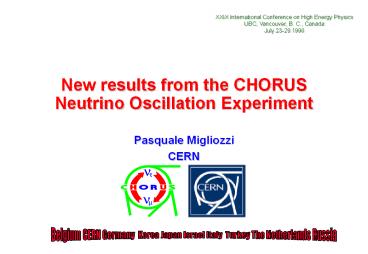New results from the CHORUS Neutrino Oscillation Experiment - PowerPoint PPT Presentation
1 / 21
Title:
New results from the CHORUS Neutrino Oscillation Experiment
Description:
XXIX International Conference on High Energy Physics. UBC, ... Tracking implies. connection of dots. in different layers. Automatic ... Flight ... – PowerPoint PPT presentation
Number of Views:24
Avg rating:3.0/5.0
Title: New results from the CHORUS Neutrino Oscillation Experiment
1
New results from the CHORUS Neutrino Oscillation
Experiment
XXIX International Conference on High Energy
Physics UBC, Vancouver, B. C., Canada July 23-29
1998
- Pasquale Migliozzi
- CERN
Belgium CERN Germany Korea Japan Israel Italy
Turkey The Netherlands Russia
2
Outline
- The CHORUS experiment
- Data
- Present results
- Outlook
- Conclusions
3
The CHORUS experiment
- Search for using the WBB at CERN
- at the Dark Matter scale (Dm21 eV2)
- Philosophy
- direct detection of t decay (kink)
EMULSION AS ACTIVE TARGET
4
The neutrino beam
The mean energy of the nm beam at the CHORUS
emulsion surface is
The anti-neutrino contamination of the beam is
The prompt nt contamination
5
n target and target tracker
- Target
- 800 kg nuclear emulsion
- (lt1mm space resolution)
- Observe the t decay topology
- (kink) in emulsion
- Purpose of electronic detector
- predict tracks back into emulsion
- kinematical cuts
- suppress background, e.g. D decays (particle id,
kinematics)
6
Data (data taking finished in 1997)
7
Microscope event view
150 mm
Emulsion to the beam
Good tracks appear as dots (grains)
120 mm
Tracking implies connection of dots in different
layers
8
Automatic scanning Track Selector(developed in
Nagoya)
9
1m channel
Signal definition (BR18)
Background
- Identify the muon track and require 0gtPmgt-30
GeV/c - no other leptons at the primary vertex
- require a kink along the muon track with PTgt250
MeV - Flight length cut (llt5plates)
- Antineutrino charm production (D-) with the
primary lepton not identified - 1.6x10-6xNCC
10
0m channel
Signal definition (BR68)
Background
- Identify a non-muon track and require
-1gtPhgt-20 GeV/c - no other leptons at the primary vertex
- require a kink along the hadron track with PTgt250
MeV - Flight length cut (llt3plates)
- Antineutrino charm production (D-) with the
primary lepton not identified - 2.3x10-6xNCC
- Neutral current events with a p- kink-like
interaction (white kink) - 2x10-5xNCC
11
Analysis steps
- Event reconstruction by electronic detectors
- track predictions in emulsion
- Automatic scanning in interface emulsion sheets
- Automatic scanning in bulk emulsion vertex
location and rejection of not-t candidates by - search for short decays (decay inside the vertex
plate) - search for long decays (decay outside the vertex
plate) - Semi-automatic eye scan and remeasuring of
retained events - Event topology and kinematics (emulsionelectronic
detector) - t- candidate or identified background
12
Vertex location
scan-back track
Location efficiency
Vertex location procedure
13
Vertex validation
Impact parameter measurement
scan-back track
Small IP normal nm event Big IP interesting
event (nt?)
Semi-automatic eye check
14
t- kink detection (parent search)
- Offline selection
- small impact parameter between
- parent and daughter
- kink point is in the vertex plate
- Semi-automatic eye check
- the events selected automatically
- are checked by eye for the final
- judgement
Principle Parent track (t) can be detected
by wider view and general angle scanning at the
vertex plate
scan-back track
Impact parameter
m or h
t
general scanning area
15
Experimental check of the t detection efficiency
- Computed using Montecarlo simulation
- Checked using events with 2 muons in the final
state (2 of the total) - locate the muon tracks in the emulsion
- scan the emulsion searching for a kink
- charm dimuon candidates (muonic D decays)
- Yield in agreement with Montecarlo assuming
scharm/sCC 5 (measured)
16
A special event
CERN-EP/98-87
Parallel session 5 July 25th talk given by O.
Melzer
17
Results
New data 31974N1m 362N0m events have been
analysed
No nt candidate has been found!
_at_ 90 C.L.
where
if i4 the m is not identified
18
CHORUS efficiencies
19
The exclusion plot (_at_ 90 C.L.)
20
Outlook
- Phase I (the present till the end of the year)
- we will just complete the scanning of the whole
statistics - we gain a factor 3 in the 1m sample
- we gain a factor 6.7 in the 0m sample
- Pmt2x10-4
- Phase II (towards the final result)
- improvements on the reconstruction algorithms are
going on - because of the increasing scanning power the kink
finding efficiency will improve by about a factor
2 - if no t candidate will be found, the proposal
sensitivity will be reached - Pmt1x10-4
21
Conclusions
- Neutrino data taking finished in 1997
- Emulsion data taking in progress
- CHORUS has shown that automatic scanning
procedures are reliable and fast - No t candidate has been found so far
- The proposal sensitivity can be reached































